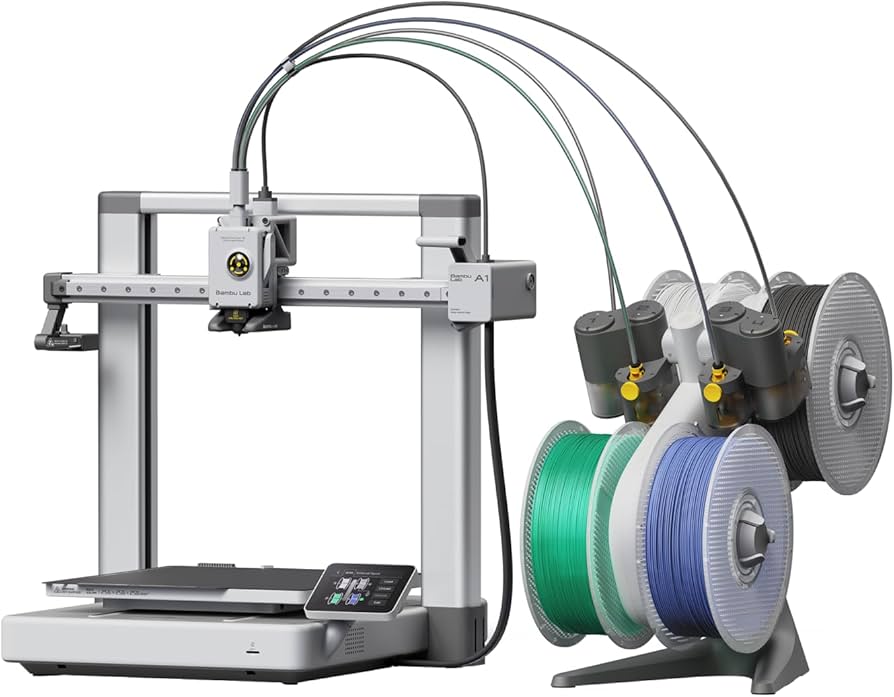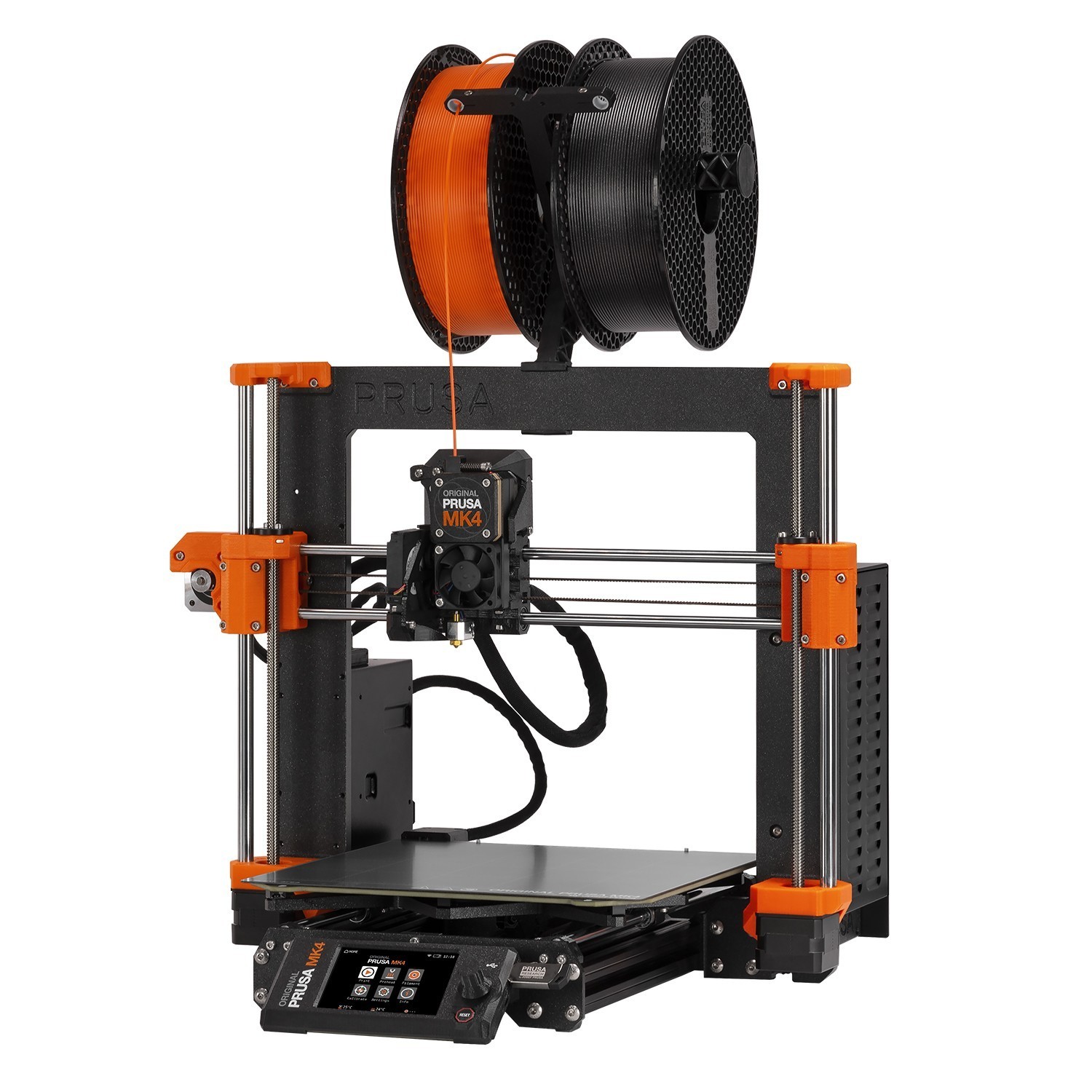Compare A1 vs Original Prusa MK4 3D Printer
Comparison between the best 3D printers
Choose the best 3D printer at the best price. The cheapest 3D printers are here.
Buy a 3D printer here with 3D Fila.
 |
 |
|
| Model | A1[BUY A1] |
Original Prusa MK4 3D Printer[BUY Original Prusa MK4 3D Printer] |
| Printing Material | Filament | Filament |
| Buy Filament for Bambu Lab A1 | Buy Filament forPrusa Original Prusa MK4 3D Printer | |
| Estimated price | $700,00 | $1099,00 |
| Manufacturer | Bambu Lab | Prusa |
| Release Year | 2023 | 2023 |
| Print Volume [mm] | 256x256x256 | 250x220x210 |
| Printer Size [mm] | 385x410x430 | 500x400x550 |
| Weight [kg] | 8,3 | 7 |
| Power Loss Recovery | YES | YES |
| Enclosed printer | NO | NO |
| Bed Leveling | Automatic | Automatic |
| Filament End Sensor | YES | YES |
| Bed type | Heated | Heated |
| Power supply system | Direct Drive | Direct Drive |
| Standard nozzle | 0,4 | 0,4 |
| Maximum Nozzle Temperature [°C] | 300 | 300 |
| Maximum Bed Temperature [°C] | 100 | 120 |
| Maximum printing speed [mm/s] | 500 | 180 |
| Filament holder | YES | YES |
| Camera for supervision | YES | YES |
| Recommended filaments | PLA, PETG, TPU, PVA | PLA, ABS, PETG, PC, Nylon, Tritan, PP |
| Recommended slicers | SuperSlicer, PrusaSlicer, Cura, OrcaSlicer | Cura, Simplify, Slic3r, IdeaMaker, PrusaSlicer e outros |
| Maximum Resolution [mm] | 0,1 | 0,1 |
| Processor | Custom 32-bit xBuddy electronics with STM32 | |
| Display | Touchscreen 3,5 | Display touchscreen 3,5'' |
| Power Supply | 350 W | 240 W |
| Connectivity | Wi-Fi, Bambu-Bus, Cartão Micro SD | USB / Wi-Fi / internet via Prusa Connect |
| Operating systems | Windows, Linux, Macbook | Windows, Mac, Linux |
| Date of registration in the system | 2024-07-17 | 2023-06-06 |
| Release date | 2023 | 2023 |
| Extra features | The BambuLab A1 printer features fully automatic calibration, multi-color printing with the AMS system, active flow rate compensation, quick nozzle change with a clip, active motor noise cancellation, a build volume of 256x256x256 mm³, a maximum extruder temperature of 300°C, and a heated bed of up to 100°C. In addition, it has high precision, a machine health management system and an intuitive 3.5-inch touchscreen interface. | The Original Prusa MK4 stands out with automatic first-layer calibration via Loadcell sensor, high-speed enabled by Input Shaper and Nextruder for precise prints. It includes quick-change nozzles, customizable UI, and Ethernet/Wi-Fi connectivity. It supports a wide range of materials, from PLA to flexibles. Equipped with a 32-bit xBuddy mainboard and precise stepper motors, it offers exceptional print quality, enhanced security, and remote printing options via Prusa Connect. |
| Support for multiple colors and materials (AMS and CFS) | YES | NO |
Notes * |
||
| Cost-benefit | 7 / 10 | 6 / 10 |
| Hardware | 4.2 / 10 | 2.8 / 10 |
| Tela | . | . |
| Print volume | 4 / 10 | 3 / 10 |
| Performance | 4 / 10 | 1 / 10 |
| [BUY A1] | [BUY Original Prusa MK4 3D Printer] |
Conclusion |
| In comparing the Bambu Lab A1 and the Original Prusa MK4 3D printers, several key factors emerge that can help potential buyers make an informed decision. The Bambu Lab A1, priced more affordably, offers a larger print volume and a higher maximum printing speed, making it particularly appealing for users prioritizing efficiency and capability. It supports multiple colors and materials, which enhances its versatility for various projects. With excellent features such as automatic calibration and an intuitive touchscreen interface, the A1 has also demonstrated strong performance with a good cost-benefit ratio. Conversely, the Original Prusa MK4, while more expensive, boasts advanced features such as high-speed capabilities enabled by Input Shaper technology and supports a broad range of materials. It emphasizes print quality and safety with features like automatic first-layer calibration and a customizable user interface. However, its performance and print volume ratings are comparatively lower than those of the A1. Ultimately, the choice between the two comes down to individual priorities. For users looking for a cost-effective option with a focus on speed and versatility, the Bambu Lab A1 is a solid choice. On the other hand, those willing to invest more for advanced print quality and material compatibility may find the Original Prusa MK4 more suitable. Each printer offers distinct advantages, ensuring that a wide range of user needs can be met in the increasingly competitive 3D printing market. |

